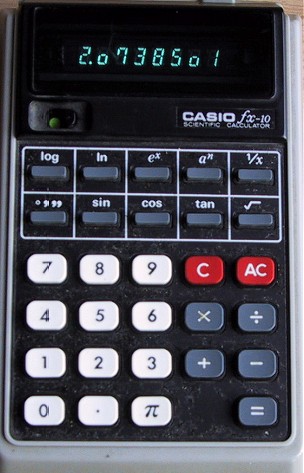casio fx-10
| here is the casio fx-10, released in may 1974, their first pocket scientific
calculator and what a splendid machine it is. the machine is quite chunky
and takes 4 AA cells.
notice the use of the small zero found on early casio models. for some reason this was standard until they decided to use the outer segments that we now recognise. the small zero looks quirky and weird by comparison. being a scientific model, i immediately put it through its paces in terms of accuracy and calculation domain. it has an interesting set of functions. sin, cos and tan but no inverses. arctan would have been nice. natural log and e^x are here, also common log. the machine works in degrees and rather helpfully has a deg/min/second button for such entry. this does not however, show the number in the (later) casio style with the time sexagesimal separated by an upper zero. instead it just divides by 60 in the right way as you enter numbers. integer powering is on offer with a^n. n can only be an integer from 0 to 9 and a is whatever is on display. it computes the result as soon as the first digit is pressed after the a^n button and clearly calculates it by repeated multiply. this is not so daft. the two reasons are time and accuracy. time because arbitrary powering can be performed manually using the logs available, which takes much longer incidentally and accuracy because some accuracy is lost powering by logs. this is exactly the approach taken by the casio fx-1 (here sold as remington). the functional domain for sin, cos and tan is not +/-360 degrees as claimed by the manual, but in fact the magic 1440 degrees of many later casios (eg fx-39) |
 |
log operates on any input, yes even negative ones. the manual admits that the sign is ignored for both logs and square roots. e^x only accepts arguments within +/-10. this must be down to the internal algorithm because e^x of bigger numbers could be displayed. notice that there is no Exp button. there is no way to supply an exponent and no exponential values are displayed. anything bigger than the 8 digits is overflow.
i discovered a fascinating secret fact with the tan function for values near 90 degrees. this was during my attempt at tan 355/226 radians as part of the torture test. interestingly values near enough to 90 degrees that cause the result to exceed 1000 are rejected as overflow (ie reported as an error). this means the closest value to 90 that tan accepts is arctan(1000) = 89.9427 and tan(89.9427) is reported as 999.93. the range exclusion around 90 is not documented but what is interesting is that the engineers knew that the results were somewhat wrong near 90 and decided to exclude this range rather than display the wrong answer. this is commendable because giving out bogus answers is bad form. it must work by performing the internal algorithm then testing against 1000 and rejecting afterwards.
something else i didnt mention that you cant see here, is the most splendid way the display flickers and dances whilst the calculations are in progress. some take a few seconds (none as long as the fx-1 which takes 16 seconds for cube root, then again this model does not have that one).